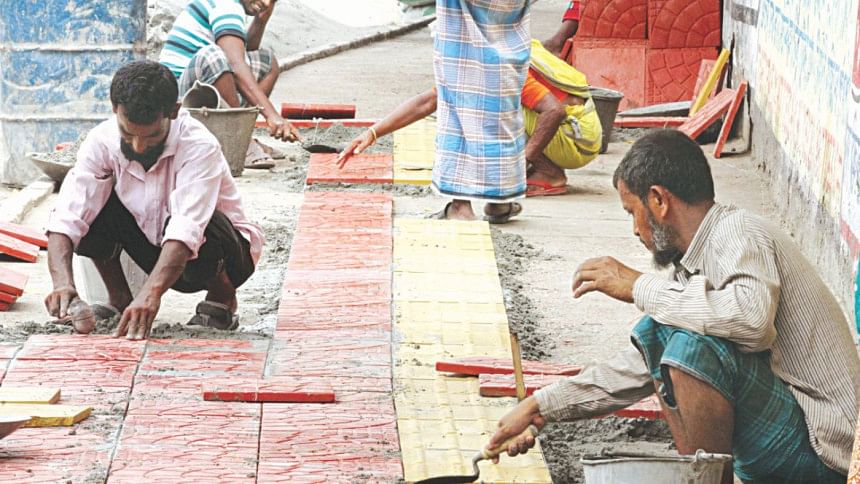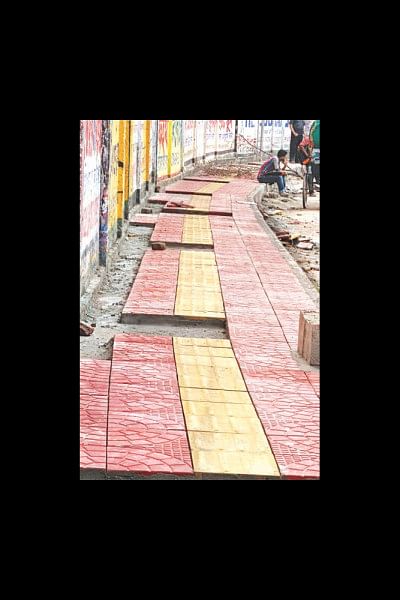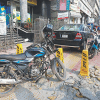Pavements with tactile track for the blind

Sarower Hossain still has some pain in his right leg.
The visually impaired man badly hurt himself after he accidentally stepped into an open manhole while walking on a pavement. The mishap happened near his home in Mirpur's Pallabi area a couple of months ago.
“I was walking on a footpath which was in a poor shape. Suddenly, I lost my balance and slipped into a manhole,” said Sarower, an assistant librarian at Dhaka University.
Every day, hundreds of people like Sarower face difficulties in walking on city pavements which do not have any textured ground surface indicator for pedestrians who are blind and visually impaired.
However, they may heave a sigh of relief as the Dhaka North City Corporation (DNCC) and the Dhaka South City Corporation (DSCC) are rebuilding all the pavements in the city to ensure their easy movement.
There would be yellow tiles with textured surface right in the middle of the footpaths, and blister surface on the edges to alert blind people about approaching streets.
The city corporations, which began the initiative last year, have already set up the special pavements in many areas of the capital.
The initiative will also ease the movement of people with disabilities, say city corporation officials.
Visiting Shahbagh, Bangla Motor, Farmgate, Banani and Basabo areas, this correspondent saw that the special pavements were either being or already had been installed.
"This move is first of its kind in the country,” Brig Gen Md Syeed Anwarul Islam, chief engineer of DNCC, told The Daily Star on Sunday.
Pedestrians face hurdles as many of the footpaths do not have proper slopes. But now, they were constructing the slopes as well, he said.
“Considering the problems of the visually impaired, we have laid a 'blind walking track' on the footpaths so that they can use them smoothly.”
“While visiting other countries, we saw such tracks on their footpaths and now, we are applying that idea here," Anwarul said, adding that gradually, all the areas of the city would have the special pavement.

At a press conference on Wednesday, DNCC Mayor Annisul Huq echoed Anwarul's statements.
Though it came late, the city corporations took the initiative considering the problems of the visually impaired people and those who use wheelchairs, he said.
Talking to The Daily Star on Monday, DSCC Chief Executive Officer Khan Mohammad Bilal said the visually impaired and the physically challenged had been demanding the special pavements for long.
He also said they were working to keep the pavements free from illegal occupation.
Contacted, Nazmul Bari, director of Center for Disability in Development, an organisation working for the people with disabilities, lauded the initiative.
The city is for all but the footpaths were not friendly for the people with disabilities, especially for the visually impaired. “This move would definitely help them move freely on the road.”
Nazmul, however, said the authorities would have to ensure that people can use the pavements without any obstacle as many of the footpaths often remain occupied.
The original tactile paving was developed by Seiichi Miyake in 1965. The paving was first introduced in a street in Okayama city, Japan, in 1967. Its use gradually spread in Japan and then around the world.

 For all latest news, follow The Daily Star's Google News channel.
For all latest news, follow The Daily Star's Google News channel. 





Comments